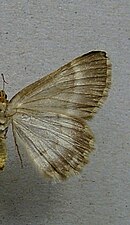Brightly banded stone tensioner
| Brightly banded stone tensioner | ||||||||||||
|---|---|---|---|---|---|---|---|---|---|---|---|---|

Light-banded stone spanner ( Charissa pullata ) |
||||||||||||
| Systematics | ||||||||||||
|
||||||||||||
| Scientific name | ||||||||||||
| Charissa pullata | ||||||||||||
| ( Denis & Schiffermüller , 1775) |
The Hellgebänderte stone tensioner ( Charissa pullata ) is a butterfly from the family of the tensioner ( Geometridae ).
features
The moths reach a wingspan of 29 to 39 millimeters. The color of the wings is variable and ranges from grayish white, light beige-gray to blackish gray. They are speckled with dark scales . There is a row of small black dots on the hem. The transverse lines are reduced to gray-brown points that are thicker and darker on the Costa loader. The discal eye spots are developed variably. The wing outer edge of the hind wings is wavy. The undersides of the wings are brownish gray. In females, the front part of the head is brown, the crown is white. The coloring, line drawing and density of pollination are variable.
The caterpillar is brown and can reach a length of up to 25 millimeters. It has a continuous yellow markings on the back and adjoining dark oblique lines on the side. The sideline is black at the top and white at the bottom. There are two pointed cusps on the 11th segment.
Similar species
The most noticeable distinguishing feature to the very similar species black line stone spanners ( Charissa intermedia ) and green- gray banded stone spanners ( Charissa glaucinaria ) are the light bands on the underside of the wings:
- In Ch. Glaucinaria these are relatively broad, but blurred,
- in Ch. intermedia they are also broad, but very rich in contrast,
- in Ch. pullata the bandages are clearly narrower.
distribution
The distribution area of the light-banded stone spanner extends from Poland in the north to Greece in the south. In the west, the species occurs in Spain and France , there especially in mountainous regions such as the Vosges , the Massif Central , the Jura and the Alps; in the departments of Saone-et-Loire , Côte-d'Or , Ain , Haute-Saône and Lot . The area extends over Central and Southern Europe to Romania in the east. The species is absent in Corsica . In Germany it occurs in the north up to the edge of the low mountain range.
The species inhabits mountainous terrain and rocky gorges with scree slopes and steep slopes. It prefers sunny and xerothermal habitats. In Switzerland the species rises up to 1,800 meters.
biology
The caterpillars are polyphagous and develop on different plants:
- Wall rue ( Asplenium ruta-muraria )
- Red honeysuckle ( Lonicera xylosteum )
- Raspberry ( Rubus idaeus )
- Common broom ( Sarothamnus scoparius )
- Broad-leaved thyme ( Thymus pulegioides )
- Mountain vetch ( Coronilla coronata )
- Common gorse ( Chamaespartium sagittale )
- Plantain trees ( Plantago )
- White sedum ( Sedum album )
- Mountain germander ( Teucrium montanum )
- Creeping gypsophila ( Gypsophila repens )
- Rock sedum ( Sedum rupestre )
- Mountain germander ( Teucrium montanum )
- Dost ( Origanum )
- Black-growing goat clover ( Cytisus nigricans )
- Blueberry ( Vaccinium myrtillus )
- Valerian ( Valeriana )
The diamond wall is preferred regionally. The caterpillars are nocturnal and rest during the day between the stalks of the food plant or in cracks in the rock. The caterpillar overwinters. The light-banded stone tensioner is now only found sporadically. It flies in one generation in Central Europe from mid-June to mid-August. The moths are nocturnal and come to light , occasionally also on bait .
Systematics
The following subspecies are known from the literature:
- Charissa pullata pullata (Denis & Schiffermüller, 1775)
- Charissa pullata albarinata (Millière, 1859)
- Charissa pullata confertata (Staudinger, 1871)
- Charissa pullata impectinata (Guenée, [1858])
- Charissa pullata kovacsi (Voinits, 1967)
- Charissa pullata nubilata ( chestnut , 1872)
Danger
The light-banded stone spanner is on the Red List of Endangered Species in Germany in Category 3 (“endangered”). The species is not endangered in Austria.
swell
Individual evidence
- ↑ a b c d Patrice Leraut: Geometrid moths . In: Moths of Europe . 1st edition. Volume II. NAP Editions, 2009, ISBN 978-2-913688-09-4 , pp. 227 (English).
- ↑ a b c Arno Bergmann: The large butterflies of Central Germany. Volume 5/2: Spanner. Distribution, forms and communities. Urania-Verlag, Jena 1955, DNB 450378411 , p. 941.
- ↑ a b c Günter Ebert (Ed.): The butterflies of Baden-Württemberg. Volume 9. Moths VII. Geometridae 2nd part . 1st edition. Ulmer, Stuttgart (Hohenheim) 2003, ISBN 3-8001-3279-6 , p. 558 .
- ↑ a b c Heiko Bellmann : The new Kosmos butterfly guide, butterflies, caterpillars and forage plants . Franckh-Kosmos, Stuttgart 2003, ISBN 3-440-09330-1 , p. 228 .
- ↑ http://lepiforum.de/cgi-bin/lepiwiki.pl?Charissa_Pullata
- ↑ Charissa pullata (DENIS & SCHIFFERMÜLLER, 1775) Light-banded stone tensioner. Heiner Ziegler, accessed on July 5, 2011 .
- ↑ Manfred Koch , Wolfgang Heinicke, Bernd Müller: We determine butterflies. Volume 4: Spanner. 2nd, improved and enlarged edition. Neumann, Leipzig / Radebeul 1976, DNB 780451570 , p. 244.
- ↑ Charissa pullata pullata in Fauna Europaea. Retrieved June 30, 2011
- ↑ Charissa pullata kovacsi at Fauna Europaea. Retrieved June 30, 2011
- ↑ Malcolm Scoble: Geometrid moths of the world. A catalog (Lepidoptera: Geometridae) . Apollo Books, Stenstrup 1999, ISBN 0-643-06304-8 , pp. 123 (English).
- ↑ Federal Agency for Nature Conservation (Ed.): Red List of Endangered Animals in Germany . Landwirtschaftsverlag, Münster 1998, ISBN 3-89624-110-9 , p. 109 .
- ↑ Costignophos pullata (Denis & Schiffermüller, 1775). Umweltbundesamt GmbH, accessed on July 5, 2011 .
Web links
- Charissa pullata at Fauna Europaea. Retrieved June 29, 2011
- Lepiforum e. V. Taxonomy and Photos
- www.pyrgus.de Species portrait and photos

